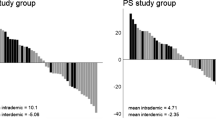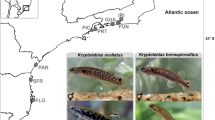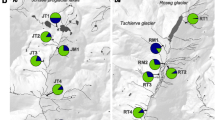Abstract
In this paper we review previous studies on sympatric Brachionus populations in Torreblanca Marsh as a model of evolutionary and ecological relationships between closely related species. The marsh is a wetland on the Mediterranean coast of Spain with high spatial and temporal heterogeneity. Allozyme and morphometric analysis showed that Brachionus group plicatilis (formerly, Brachionus plicatilis and currently split into B. plicatilis and B. rotundiformis) was composed of three groups of genotypes with no evidence of gene flow between them (B. plicatilis, B. rotundiformis SM and B. rotundiformis SS). Correlations between seasonal and spatial distributions, on one hand, and temperature and salinity, on the other hand, were consistent with the results of experimental studies on population dynamics. Accordingly, B. plicatilis is a euryhaline, low temperature group; B. rotundiformis SM is adapted to high temperature and low salinity conditions; and B. rotundiformis SS is adapted to high temperature and high salinity conditions. The groups had different mictic responses to density, salinity and temperature, which can be explained to some extent as an adaptive escape response, given their different ecological preferences. These differences imply a partial ecological barrier to male–female encounter between groups. Mating experiments showed that most copulations occurred within a group. B. plicatilis has a mating recognition system different from those of either B. rotundiformis SM or SS, whereas the two B. rotundiformis groups had partially differentiated mating preferences. Cross-mating experiments performed in the laboratory failed to produce any detectable hybrids. We conclude that three sympatric sibling species inhabit Torreblanca Marsh. The remarkable association between genetic differences among clonal groups and their ecological preferences, mixis response and mating behavior is hypothesized to play a role in stabilizing sympatry, and gives insight into the evolution of genetic divergence and speciation in rotifers.
Similar content being viewed by others
References
Aparici, E., M. J. Carmona & M. Serra, 1998. Sex allocation in haplodiploid cyclical parthenogens with density-dependent proportion of males. Am. Nat. 152: 652–657.
Avise, J. C., 1994. Molecular Markers, Natural History and Evolution. Chapman and Hall, New York: 511 pp.
Brooks, J. L. & S. I. Dodson, 1965. Predation, body size and composition of the plankton. Science 150: 28–35.
Butlin, R., 1989. Reinforcement of premating isolation. In Otte, D. & J. A. Endler (eds), Speciation and its Consequences. Sinauer Associates, Sunderland, MA: 158–179.
Carmona, M. J., M. Serra & M. R. Miracle, 1993. Relationships between mixis in Brachionus plicatilis and preconditioning of the culture medium by crowding. Hydrobiologia 255/256 (Dev. Hydrobiol. 83): 145–152.
Carmona, M. J., A. Gómez & M. Serra, 1995. Mictic patterns of Brachionus plicatilis in small ponds. Hydrobiologia 313/314 (Dev. Hydrobiol. 109): 365–371.
Carson, H. L., 1994. Fitness and the sexual environment. In Lambert, D. M. & H. G. Spencer (eds), Speciation and the Recognition Concept: Theory and Application. The Johns Hopkins University Press, Baltimore: 126–137.
Doebeli, M., 1996. A quantitative genetic competition model for sympatric speciation. J. Evol. Biol. 9: 893–909.
Endler, J. A., 1989. Conceptual and other problems in speciation. In Otte, D. & J. A. Endler (eds), Speciation and its Consequences. Sinauer Associates, Sunderland, MA: 625–648.
Fu, Y., K. Hirayama & Y. Natsukari, 1991a. Genetic divergence between S and L type strains of the rotifer Brachionus plicatilis O.F. Müller. J. exp. mar. Biol. Ecol. 151: 43- 56.
Fu, Y., K. Hirayama & Y. Natsukari, 1991b. Morphological differences between two types of the rotifer Brachionus plicatilis O. F. Müller. J. exp. mar. Biol. Ecol. 151: 29–41.
Fu, Y., A. Hagiwara & K. Hirayama, 1993. Crossing between seven strains of the rotifer Brachionus plicatilis. Nippon Suisan Gakkaishi 59: 2009–2016.
Gilbert, J. J., 1963. Contact chemorreception, mating behaviour, and sexual isolation in the rotifer genus Brachionus. J. exp. Biol. 40: 625–641.
Gilbert, J. J., 1974. Dormancy in rotifers. Trans. am. Micros. Soc. 93: 490–513.
Gómez, A., 1996. Ecología genética y sistemas de reconocimiento de pareja en poblaciones simpátricas de rotíferos. Ph.D. dissertation, University of Valencia, Valencia, Spain.
Gómez, A. & M. Serra, 1995. Behavioral reproductive isolation among sympatric strains of Brachionus plicatilis Müller, 1786: Insights into the status of this taxonomic species. Hydrobiologia 313/314 (Dev. Hydrobiol. 109): 111–119.
Gómez, A. & M. Serra, 1996. Mate choice in male Brachionus plicatilis rotifers. Funct. Ecol. 10: 681–687.
Gómez, A. & T. W. Snell, 1996. Sibling species in the Brachionus plicatilis species complex. J. Evol Biol. 9: 953–964.
Gómez, A., M. Temprano & M. Serra, 1995. Ecological genetics of a cyclical parthenogen in temporary habitats. J. Evol. Biol. 8: 601–622.
Gómez, A., M. J. Carmona & M. Serra, 1997. Ecological factors affecting gene flow in the Brachionus plicatilis complex (Rotifera). Oecologia 111: 350–356.
Hagiwara, A. & C. S. Lee, 1990. Resting egg formation of the L-and S-type rotifer Brachionus plicatilis under different water temperature. Nippon Suisan Gakkaishi 57: 1645–1650.
Hagiwara, A., A. Hino & R. Hirano, 1985. Combined effects of environmental conditions on the hatching of fertilized eggs of the rotifer Brachionus plicatilis collected from an outdoor pond. Bull. jpn. Soc. Sci. Fish. 51: 755–758.
Hagiwara, A., C. S. Lee, G. Miyamoto & A. Hino, 1989. Resting egg formation and hatching of the S-type rotifer Brachionus plicatilis at varying salinities. Mar. Biol. 103: 327–332.
Hagiwara, A., M. M. Jung, T. Sato & K. Hirayama, 1995. Interspecific relationships between marine rotifer Brachionus rotundiformis and zooplankton species contaminating in the rotifer mass culture tank. Fish. Sci. 61: 623–627.
Hino, A. & R. Hirano, 1984. Relationship between water temperature and bisexual reproduction rate in the rotifer Brachionus plicatilis. Bull. jpn. Soc. Sci. Fish. 50: 1481–1485.
Hino, A. & R. Hirano, 1988. Relationship between water chlorinity and bisexual reproduction rate in the rotifer Brachionus plicatilis. Nippon Suisan Gakkaishi 54: 1329–1332.
Hirayama, K., 1985. Biological aspects of the rotifer Brachionus plicatilis as a food organism for mass culture of seedling. Coll fr-jpn Oceanogr., Marseille 8: 41–50.
Hutchinson, G. E., 1967. A Treatise on Limnology, Vol. 2. J. Wiley, New York.
Ito, S., H. Sakamoto, M. Hori & K. Hirayama, 1981. Morphological characteristics and suitable temperature for the growth of several strains of the rotifer, Brachionus plicatilis. Bull. Fac. Fish., Nagasaki Univ. 51: 9–16.
Jenkins, D. G., 1995. Dispersal-limited zooplankton distribution and community composition in new ponds. Hydrobiologia 313/314 (Dev. Hydrobiol. 109): 15–20.
King, C. E., 1972. Adaptation of rotifers to seasonal variation. Ecology 53: 408–418.
King, C. E., 1977a. Genetics of reproduction, variation, and adaptation in rotifers. Arch. Hydrobiol. Beih. Ergebn. Limnol. 8: 187–201.
King, C. E., 1977b. Effects of cyclical ameiotic parthenogenesis on gene frequency population size. Arch. Hydrobiol. Beih. 8: 207- 211.
King, C. E., 1980. The genetic structure of zooplankton populations. In Kerfoot, W. C. (ed.), Evolution and Ecology of Zooplankton Communities. University Press of New England, Hanover, NH: 315–328.
King, C. E., 1993. Random genetic drift during cyclical ameiotic parthenogenesis. Hydrobiologia 255/256 (Dev. Hydrobiol. 83): 205–212.
King, C. E. & M. R. Miracle, 1980. A perspective on aging in rotifers. Hydrobiologia 73 (Dev. Hydrobiol. 1): 13–19.
King, C. E. & P. Murtaugh, 1997. Effects of asexual reproduction on the neighborhood area of cyclical parthenogens. Hydrobiologia 358 (Dev. Hydrobiol. 124): 55–62.
King C. E. & M. Serra, 1998. Seasonal variation as a determinant of population structure in rotifers reproducing by cyclical parthenogenesis. Hydrobiologia 387/388 (Dev. Hydrobiol. 134): 361–372.
King, C. E. & Y. Zhao, 1987. Coexistence of rotifer (Brachionus plicatilis) clones in Soda Lake, Nevada. Hydrobiologia 147 (Dev. Hydrobiol. 42): 57–64.
Knowlton, N., 1993. Sibling species in the sea. Annu. Rev. Ecol. Syst. 24: 189–216.
Lambert, D. M, B. Michaux & C. S. White, 1987. Are species self defining? Syst. Zool. 36: 196–205.
Lande, R., 1981. Models of speciation by sexual selection on polygenic traits. Proc. natl. Acad. Sci. U.S.A. 78: 3721–3725.
Lubzens, E., R. Fishler & V. Berdugo-White, 1980. Induction of sexual reproduction and resting egg production in Brachionus plicatilis reared in seawater. Hydrobiologia 73 (Dev. Hydrobiol. 1): 55–58.
Lubzens, E., G. Minkoff & S. Marom, 1985. Salinity dependence of sexual and asexual reproduction in the rotifer Brachionus plicatilis. Mar. Biol. 85: 123–126.
Lynch, M., 1983. Ecological genetics of Daphnia pulex. Evolution 37: 358–374.
Mayr, E., 1970. Populations, Species and Evolution. Harvard University Press, Cambridge, MA: 453 pp.
Minkoff, G., E. Lubzens & D. Kahan, 1983. Environmental factors affecting hatching of rotifer (Brachionus plicatilis) resting eggs. Hydrobiologia 104 (Dev. Hydrobiol. 14): 61–69.
Miracle, M. R. & M. Serra, 1989. Salinity and temperature influence in rotifer life history characteristics. Hydrobiologia 186/187 (Dev. Hydrobiol. 52): 81–102.
Pascual, E. & M. Yúfera, 1983. Crecimiento en cultivo de una cepa de Brachionus plicatilis O.F.Müller en función de la temperatura y la salinidad. Invest. Pesquera 47: 151–159.
Paterson, H. E. H., 1978. More evidence against speciation by reinforcement. South Africa J. Sci. 74: 369–371.
Paterson, H. E. H., 1982. Perspective of speciation by reinforcement. South Africa J. Sci. 78: 53–57.
Paterson, H. E. H., 1985. The recognition concept of species. In Vrba, E. S. (ed.), Species and Speciation. Transvaal Museum Monograph No. 4, Pretoria: 21–29.
Paterson, H. E. H., 1993. Evolution and the Recognition Concept of Species. Collected writings. McEvey, S. F. (ed.). The Johns Hopkins University Press, Baltimore, MD, EEUU.
Peters, R. H., 1983. The Ecological Implications of Body Size. Cambridge University Press, New York.
Pourriot, R. & T. W. Snell, 1983. Resting eggs of rotifers. Hydrobiologia 104 (Dev. Hydrobiol. 14): 213–224.
Pozuelo, M. & L. M. Lubián, 1993. A sexual and sexual reproduction in the rotifer Brachionus plicatilis cultured at different salinities. Hydrobiologia 255/256 (Dev. Hydrobiol. 83): 139- 143.
Rico-Martínez, R. & T. W. Snell, 1995a. Copulatory behavior and mate recognition pheromone blocking of male receptors in Brachionus plicatilis Müller (Rotifera). Hydrobiologia 313/314 (Dev. Hydrobiol. 109): 105–110.
Rico-Martínez, R. & T. W. Snell, 1995b. Male discrimination of female Brachionus plicatilis Müller and Brachionus rotundiformis Tchugunoff (Rotifera). J. exp. mar. Biol. Ecol. 190: 39–49.
Segers, H., 1995. Nomenclatural consequences of some recent studies on Brachionus plicatilis (Rotifera, Brachionidae). Hydrobiologia 313/314 (Dev. Hydrobiol. 109): 121–122.
Serra, M., 1987. Variación morfométrica, isoenzimática y demográfica en poblaciones de Brachionus plicatilis: diferenciación genética y plasticidad fenotípica. Ph.D. dissertation, University of Valencia, Valencia, Spain.
Serra, M. & M. J. Carmona, 1993. Mixis strategies and resting egg production of rotifers living in temporally-varying habitats. Hydrobiologia 255/256 (Dev. Hydrobiol. 83): 117–126.
Serra, M & C. E. King (in press). Optimal rates of bisexual reproduction in cyclical parthenogens with density dependent growth. J. Evol. Biol.
Serra, M. & M. R. Miracle, 1985. Enzyme polymorphism in Brachionus plicatilis populations from several Spanish lagoons. Verh. int. Verein. Limnol. 22: 2991–2996.
Serra, M., A. Galiana & A. Gómez, 1997. Speciation in monogonont rotifers. Hydrobiologia 358 (Dev. Hydrobiol. 124): 63–70.
Snell, T. W., 1980. Blue-green algae and selection in rotifer populations. Oecologia 46: 343–346.
Snell, T. W., 1986. Effect of temperature, salinity and food level on sexual and asexual reproduction in Brachionus plicatilis (Rotifera). Mar. Biol. 92: 157- 162.
Snell, T. W., 1987. Sex, population dynamics and resting eggs production in rotifers. Hydrobiologia 144: 105–111.
Snell, T. W., 1989. Systematics, reproductive isolation and species boundaries in monogonont rotifers. Hydrobiologia 186/187 (Dev. Hydrobiol. 52): 299–310.
Snell, T. W. & E. M. Boyer, 1988. Thresholds for mictic-female production in the rotifer Brachionus plicatilis (Müller). J. exp. mar. Biol. Ecol. 124: 73–85.
Snell, T. W. & C. A. Hawkinson, 1983. Behavioral reproductive isolation among populations of the rotifer Brachionus plicatilis. Evolution 37: 1294–1305.
Snell, T. W. & F. J. Hoff, 1987. Fertilization and male fertility in the rotifer Brachionus plicatilis. Hydrobiologia 147 (Dev. Hydrobiol. 42): 329–334.
Snell, T. W. & P. D. Morris, 1993. Sexual communication in copepods and rotifers. Hydrobiologia 255/256 (Dev. Hydrobiol. 83): 109–116.
Snell, T. W. & B. C. Winkler, 1984. Isozyme analysis of rotifer proteins. Biochem. Syst. Ecol. 12: 199–202.
Snell, T. W., R. Rico-Martínez, L. N. Kelly & T. E. Battle, 1995. Identification of a sex pheromone from a rotifer. Mar. Biol. 123: 347–353.
Templeton, A. R., 1989. The meaning of species and speciation: a genetic perspective. In Otte, D. & J. A. Endler (eds), Speciation and its Consequences. Sinauer Associates, Sunderland, MA: 3- 27.
Zhao, Y. & C. E. King, 1989. Ecological genetics of the rotifer Brachionus plicatilis in Soda Lake, Nevada, EEUU. Hydrobiologia 185: 175–181.
Author information
Authors and Affiliations
Rights and permissions
About this article
Cite this article
Serra, M., Gómez, Á. & Carmona, M.J. Ecological genetics of Brachionus sympatric sibling species. Hydrobiologia 387, 373–384 (1998). https://doi.org/10.1023/A:1017083820908
Issue Date:
DOI: https://doi.org/10.1023/A:1017083820908




